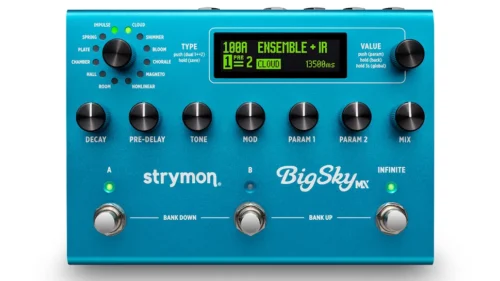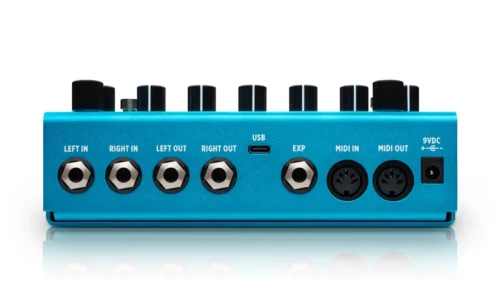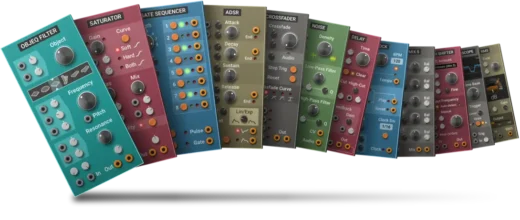The Strymon Big Sky MX Is The Best Reverb Pedal Ever?
Today, Strymon has unveiled its most powerful reverb pedal, the BigSky MX, a new version of their popular flagship reverb and expands it out of sight, deploying a tri-core 800 MHz ARM processor to bring players the “absolute best ambiences” the guitar effects specialist has ever put together.
And, there are many new features to get the most of out its sounds – as with the original BigSky, which launched in 2013, the spec on this is bewildering.
If the BigSky MX is not the ultimate reverb pedal it is certainly in the conversation, with the pedal deploying a dual-engine approach that lets players run their electric guitar signal through two reverb algorithms at once, in series or parallel. And with full stereo operation you also have the option of individually panning these reverbs left and right.
When you are running two reverbs at once, you can assign footswitches to each sound so you can bring them in and out of the mix. Whether you are dialling in reverbs to add some sheen and space, to creating a black hole of ambience, there are myriad ways of controlling your settings and fine tuning your sound.
There are 12 reverb engines here, each selectable as before via the rotary dial, with LEDs illuminating the active engine. Seven of these have been engineered from the ground up, the rest have been tidied up and enhanced. Impulse and Chamber are totally new. Spring, Plate, Hall, Room and Shimmer sound familiar but are all-new algorithms – though with the original BigSky voicings for each still available.
Strymon used a “state-of-the-art gradient descent algorithm” to weed out unwanted artefacts and ringing in their sounds. State-of-the-art vibe is very much the prevailing vibe.
The BigSky MX feeds your signal through discrete Class A JFET input preamps. Around the back of the pedal you have stereo inputs and outputs, an expression pedal input, and there are MIDI and USB connections for making deep edits and managing your presets.
But on-unit adjustments are made easy by an intuitive control layout and a bright OLED display screen that should be visible under difficult light – and crucially presents players with all the information they need to manage their presets and preside over two reverbs at the same time.
Gregg Stock, CEO and co-founder, Strymon, says the BigSky MX has been almost four years in the making, and presents a high-water mark for the company’s industry standard reverb.
“It’s been a labour of love, and we knew that the legions of original BigSky fans were counting on us to get it right the first time,” he says. “In the end it exceeded all of our expectations, and we’re really happy with how it turned out.
“The 12 engines in BigSky MX produce the absolute best ambiences we’ve ever made, and the ability to run two engines at once and the impulse stuff is a major step forward.”
And, yes, the impulse stuff. This is another great evolutionary leap for the unit, augmenting the newly design reverb engines with IR captures of vintage gear. That new convolution engine does a lot of heavy lifting with this unit, allowing for 10 seconds of stereo impulse response playback per instance, and these IRs are also editable.
“The new algorithms are bigger, wider and cleaner than anything we’ve been able to achieve in the past, and impulse response playback is a welcome addition,” says Pete Celi, Strymon’s co-founder and DSP engineer. “We’ve included our very own long captures of some classic studio devices and some oddball vintage units collected by one of our engineers too, so there is an entire world of creative reverb in there to explore.”
Features:
- Two discrete reverbs, with Series, Parallel and Split audio routing/new pan control per engine
- 7 new reverb machines, plus significant enhancements to Big Sky classics, 12 reverb types x 2 engines in total
- 2 brand new algorithms, Impulse (IR) and Chamber. Spring, Plate, Hall, Room + Shimmer feature new algorithms, with option to select original BigSky voices
- 22 pre-loaded IR’s feature 10sec IR playback with full editing capability and custom long-IR captures of classic studio gear
- Stereo i/o with selectable input level for instrument/line level, Strymon Class A JFET input preamps, and selectable true/buffered bypass
- Dedicated Infinite/Freeze footswitch (create lush pads to play over) crisp OLED display, DIN and TRS MIDI I/O, USB-C, EXP inputs
- Zero-latency analogue dry path
- EXP input to connect optional TRS expression pedal, MultiSwitch, MultiSwitch Plus, or TRS MIDI
- USB-C jack for firmware updates, MIDI I/O, and patch upload/download/real time desktop parameter control/IR loading via Strymon’s free Nixie 2 editor
- 24-bit, 96 kHz, 116 dB typical Signal/Noise, dual ultra high-performance 800MHz tri-core 32-bit floating ARM processors


Like its predecessor, the BigSky MX is designed and made in California.
The Strymon BixSky MX is available now for $679.
Is the Strymon BigSky MX the best reverb pedal ever? Check out the details and share your thoughts in the comments!



